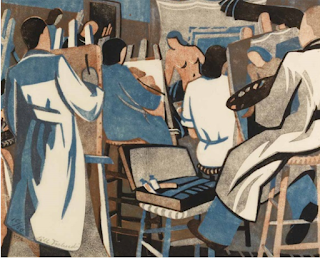Sooner than expected the question of attribution was solved by my American collecting friend and print expert Tom Clemens in Boston who's friend Ben Weiss, curator of Boston Museum of Arts, identified the print by a copy in New-York Metropolitan Museum of Art database in the Garfield collection.
https://www.metmuseum.org/art/collection/search/835184
Its title, to me and my special collection, is adding an extra layer of interest and emotion to her work:
"Neue Flüchtlinge kommen ins Lager".
New, Jewish, refugees fleeing Nazi Germany in 1944, seeking and finding shelter, arriving in Switzerland. It also solves the question which side of the paper is front and besides gives insight in her actual printing technique and her use of materials.
Unexpectedly it is also of a frightening actuality.
During WW-II Switzerland sheltered some 300.000 mostly Jewish refugees, but controversially also send many back at its frontiers following the "all life boats are full" principle. A frightening and haunting resemblance and food-for-thought and contemplation to today's (European) migratory problems.
























